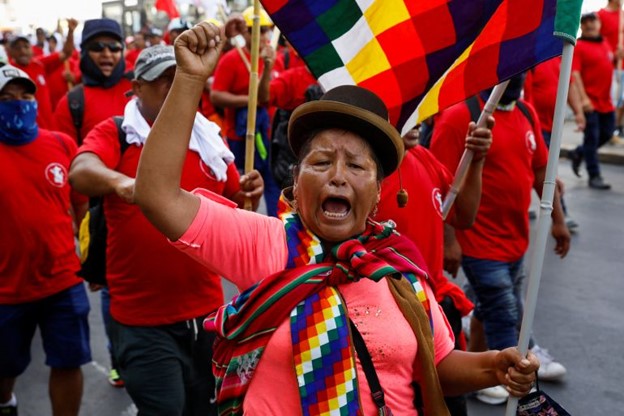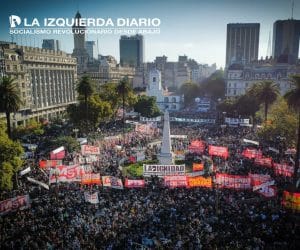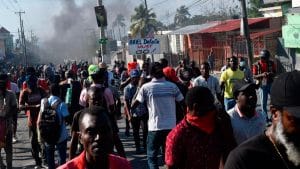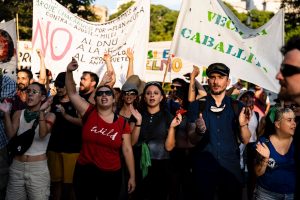In Peru, anger erupted as a result of the fact that millions of campesinos and indigenous people had voted for Pedro Castillo — a teacher from a rural background who is seen as one of their own — who was ousted from power in December. This came in the midst of a political crisis that has dragged on, with five presidents in the past six years. Despite not keeping his electoral promises, such as the call for a Constituent Assembly, the end of extractivist contracts, or free university education, along with ceding more and more ground to the Right, and even in spite of having repressed rural workers — including one protest where four people were murdered — Castillo was never accepted by a deeply racist regime.
The uprising began in December against the parliamentary coup that put Dina Boularte, Castillo’s vice president, in power, following a desperate attempt by Castillo to close Congress after multiple attempts by right-wing legislators to impeach him, and having lost the support of his own party. There was fierce repression, which inflamed demonstrators even more, unleashing roadblocks in the interior of the country (the poorest regions), with its epicenter in Puno. Afterward the calls to “take Lima” began. Other than “truces” during the weeks of Christmas and New Years, and during Carnaval, these uprisings have continued since December, with ebbs and flows. However, in the last few weeks, there has been more of a retreat.
However, the reasons for the uprisings are much deeper. Thousands of campesinos, workers and indigenous people suddenly emerged onto the political arena, questioning the legacy of neoliberalism and the Fujimori dictatorship, as well as racism against the indigenous population. The shocking photos that our Peruvian comrades showed us of a rich wedding symbolize the disparities that exists in Peru: the daughter of a Peruvian businessman and grandson of a Spanish Count married ten months ago with an abhorrent spectacle reminiscent of indigenous slavery from colonial times, with kneeling women with bowed heads and bound men.
The suffering of the majority of the population is unimaginable. In the streets of Lima, the 80% rate of labor informality is visible, with the streets full of carts of food vendors, elderly people offering to weigh others on a scale for a small fee, and cab drivers working up to fourteen hours. Health and education is privatized. Houses are built with what little people have, on hills where avalanches of rain and rockslides destroy everything in their path and take dozens of lives in a matter of minutes. In Puno, eight out of ten children between six months and three years old suffer from anemia. The neoliberal model defended by libertarian Javier Milei and the center-right political coalition, Juntos por el Cambio in Argentina, is showing its complete failure in Latin America; after Chile, Colombia, and Ecuador, now it’s emerging in Peru.
Class Struggle
I arrived in Peru on Wednesday, February 1, and on the following Saturday residents of migrant slums held a march. That day we saw the strength of the delegations sent by communities from the interior of the country. From the north, south, east, and center of Lima, 30,000 campesinos marched to Plaza 2 de Mayo. On that day, at the height of the crisis, these communities blocked off 140 roads throughout the country affecting 20 percent of mining production, held actions in the capital, and took over entire cities. They put forward slogans against racism, as well as against the handing over of resources to the mining companies that destroy the environment and exploit the people. They continued fighting despite strong repression, as was the case during other actions. More than 70 were murdered, according to information we could gather.
Moreover, during this mobilization workers and students took to the streets. The students staged a heroic show of solidarity at the National University of San Marcos, founded in 1551, an institution with colonial roots. After almost 500 years, students came together and opened the doors to the delegations of indigenous and rural people. In response, the ruling class sent tanks and rifles to attempt to break their solidarity. We had the opportunity to meet several young students from the university, who didn’t give up in the face of this repression. These students also continued to debate which perspectives to bring forth to the mobilization.
It was impressive seeing the protests and the streets full of demonstrators. The youth were at the front with shields, self-organized groups deactivated tear gas, and the Quechua and Aymara women demonstrated in their dresses. Thousands were willing to fight, shouting, reminding those who want to declare the “end of history” and the triumph of capitalism, that history continues to be written with class struggle in Latin America and throughout the world. Peru is just one more example, among others internationally, such as the recent uprisings of French workers and students confronting Macron’s pension reform, that the worldwide masses are exercising their power to determine the course of history.
Why Hasn’t Boluarte Fallen?
Despite the mobilizations, Dina Boluarte’s government is still in power. Why hasn’t Boluarte fallen? This is the question in every conversation, in every workers’ meeting, during marches or in a bar, before and after street mobilizations. It’s a debate that the comrades of La Izquierda Diario Perú and the Socialist Workers Current (CST) took on to try to find answers, because there are historical problems that the masses need to resolve.
The first conclusion so far is that it is necessary for the working class to enter decisively into the struggle, with its strategic position in production, logistics, and services, which make it capable of paralyzing the country through a general strike, which could put a stop to the coup government. Moreover, the working class has the potential to reorganize society, as workers are the ones that move the economy and create the capitalists’ profits. At the same time, they can bring together and coordinate different sectors in struggle, in democratic spaces that strengthen mobilizations and seek to give an answer to the deep sufferings of the masses.
Although workers did participate in the uprising, it was in a dispersed manner, and not with their mass organizations — their unions — leading. Moreover, a large part of the Peruvian labor force is informal, which leads to very high levels of fragmentation among workers. In spite of this, the workers in Peru do immense mining, fishing, and food production, as well as run a huge ports logistics system (and are constructing the biggest port in Latin America with Chinese capital). From these sectors — which define the activity and growth of the country, appropriated by a few wealthy capitalists — can unite in struggle with the exploited and oppressed, and develop a response to problems such as land, housing, health and education, labor precarity, child exploitation, and the high cost of living.
On February 9, the Central General de Trabajadores de Perú (CGTP) called for an “indefinite strike.” However, this public declaration was made to demobilize thousands of workers, not to call for an actual strike. The bureaucracy, in this case the Partido Comunista de Perú, while critical of Boluarte, took it upon itself to prevent assemblies from forming in workplaces in preparation of the strike. They also reached a consensus with the Ministry of Labor of the coup government on the terms and conditions of the strike. The “indefinite strike” only ended up being one afternoon after the workday, and didn’t even fight to guarantee the workers’ wages for that day.
It ended up being a tragedy. The leadership of the CGTP ended the demonstration after an hour and a half, leaving the campesinos exposed to the repression of the Peruvian National Police. When thousands of workers were present, the police didn’t dare fire a single bullet. The strike could have been a strident demonstration of what workers’ power could do if deployed to its fullest strength, but it was subdued because of the role played by the leadership. The CGTP, founded in the 1920s by Peruvian Marxist José Carlos Mariátegui, played a reactionary role because of the politics of Stalinism in Peru.
On the other hand, regional mobilizations in the interior of Peru, with large campesino participation, also included agroindustrial workers, like those of Ica, el Barrio Chino, and northern Chao. Some mining and industrial centers and heavy transport were also mobilized. Once again, the leadership of these mobilizations were at the forefront. An example is the mining strike that spontaneously developed at the beginning of the uprising against inhumane working conditions. The bureaucracy withdrew its support of the union for this strike “so that they would not join in solidarity with the campesinos nor take up political fights.”
Despite this leadership, thousands of teachers, textile and telephone workers, among others, took to the streets on the day of the strike. The contingent of civil construction workers was most powerful, visible in a sea of red vests that flooded the capital, showing their willingness to fight. These construction workers are the ones who build the large buildings used for real estate speculation, which stay empty in the wealthy district while thousands are homeless.
The second conclusion, expressed in articles and public debates presented in La Izquierda Diario Perú, is the necessity of overcoming the lack of coordination between different sectors.
Closely linked to this problem is that the struggle of the Peruvian people is eminently political, and requires a leadership that does not have alliances with the government nor the parties of the regime.
The lack of coordination — highlighted as a major problem by all the participants with whom we had the chance to debate — is the result of the policies of the CGTP leadership itself, which used its forces to negotiate with the regime for only wage demands, and disarmed the power of the mobilization. Also contributing was the influence of Maoist currents in the leaderships of rural committees. These, far from developing a unified and democratic movement, subdue the assemblies that arise from the will of the mobilized sectors. In order to do that, they imposed antidemocratic measures, not allowing voting by those engaged in the battles. On the other hand, they developed a policy of the “long march,” funneling the energy of thousands of campesinos into dispersed “sacrificial” mobilizations. These different delegations mobilized separately for miles and miles, with only the objective of exhausting clashes with the police.
Ana Aguilar, a leader of the rural patrols of Lampa (Puno) whom we met during the ebbs and flows of mobilizations, explained this to us. She told us firsthand how her relatives and neighbors suffered repression and lost loved ones. Her anger constantly clashed with the leadership of the Comité Nacional Unificado de Lucha de Perú (Unified National Committee of Struggle of Peru): “They don’t let us have a say or vote on what we are going to do, they make us march and march without deciding anything. They are wearing us down.” Following this, she set up another coordinating committee, which seeks solidarity from the workers and students of Lima.
Another example is the fight that our comrades Carla and Ricardo continue to carry on within a committee that developed in the San Juan de Lurigancho district in Lima, the most populated in the country. Dozens of workers and inhabitants of this region are beginning to sympathize with and support the motions of the CST, which seek to sow a tradition of democratic debate from below, and show that the actions of this district coincide with the various sectors in struggle throughout Lima. They do this by confronting Maoism and the bureaucratic leadership of the assembly, which was forced to allow the vote of all the participants.
In conclusion, the nationalization and bureaucratization of the organizations leading the mobilization were the main obstacle to success in uniting the forces of all the sectors in struggle, to bring forth the power of the working class, and succeed in overthrowing the coup government, opening a revolutionary situation. In spite of the fact that the CST is still a small and young current, it is sowing in various sectors a set of practices and methods that never before existed in Peru, characteristic of a strategy to win. At the same time, they are beginning to develop a program in the heat of events from a working class perspective.
Change of Consciousness and New Foundations
In his book De la Movilización a la Revolución (From Mobilization to Revolution, Ediciones IPS, 2022), Matías Maiello develops reflections for thinking about the revolution in the twenty-first century. Returning to Trotsky, he states that:
Institutions never change to the extent needed by society. Even when in deep crisis, long periods can pass in which the opposition forces do nothing more than act as catharsis to ease the discontent of the masses, thus guaranteeing the stability of the dominant social regime (….). This chronically regressive character of ideas and human relations in relation to the conditions in which they exist means that when such conditions collapse in a catastrophic manner, making the status quo unbearable for the masses and causing their eruption on to the political scene, the change in consciousness in a few days exceeds those of years of peaceful evolution.
Indeed, the regime in Peru is collapsing and every day is like a month in this political crisis. The indignation at the institutions of the capitalist State is expressed in the fact that 90% of the population supports closing Congress, full of politicians who live well in the midst of blatant repression. Both parties have abandoned the masses: both the Fujimoristas and the self-styled “leftists” — who also support Dina Boluarte — are rejected. They do not want to allow an early election, because the politicians don’t want to lose the benefit of having their savings in Peru’s Central Bank held in U.S. dollars, which could be a result of losing their positions. In daily conversations, there is the feeling that the current institutions are no longer useful, that the “representatives” cannot provide any solution or answer to the crisis that Peru is going through, and that Congress, the Executive and the Judiciary are corrupted. Some frequent comments include “We are fed up,” “the people have to decide,” and “this cannot be solved with a new president.”
During this eventful month we had the pleasure of meeting many people. In addition to the comrades of the CST, students from the National University of Mayor de San Marcos and the National University of Engineering, we met trade and textile workers, young doctors, and campesinos from Puno and Cusco. Just as the reality of the country changed minute by minute, so did the conscience of the masses.
Debates about having a Constituent Assembly were common, with the slogan “For a Free and Sovereign Constituent Assembly” having 70% approval. However, what does it mean that it should be Free and Sovereign? Who should convene it? The same political parties that defend this constitution (the same Constitution from the Fujimori dictatorship)? Or should it arise from below, from the institutions that the thousands of campesinos, workers and students could build during the process of class struggle? To deliberate on this, about 60 delegates came to the Leon Trotsky socialist cultural house, which we founded in the last week of our trip in the heart of downtown Lima.
The thousands who are fighting wonder what it will take to win. Suddenly they are looking for answers, for a perspective that embodies the reasons for their struggle. Not only to oust Boluarte from power, but also to end the unheard-of suffering that plagues their living conditions. During a large mobilization, we decided to hand out a leaflet again, which started out by us bringing it to the contingents of workers, but ended up handing it out without much effort — we stood while workers took them from our hands. Dozens of people would simply come up to look at the leaflet to find out what it said, and then express a political awakening.
What Will Tip the Scales?
On Wednesday, February 15, we held a conference together with Alejandrina Barry, Buenos Aires legislator, and the national deputy Alejandro Vilca, from the PTS in the Frente de Izquierda Unidad. They traveled to Peru to promote international solidarity as well as to compile denunciations of human rights violations. There, Jorge, a commerce worker from Ripley, said that the most important thing is the fight to achieve the solidarity of the working class of Lima with the struggle of the interior regions of Peru, and that “it is necessary to build a working-class party of our own to achieve this.”
This is the enormous task that the comrades of La Izquierda Diario Perú and the CST have taken up. Being aware that in the present moment our current does not have sufficient strength to change the course of events, they are making an enormous effort to sow another political tradition in the advanced sectors that participate in the struggle. And to converge with workers, students and residents to convince them that the essential task of this moment is to reach a milestone, to lay the foundations to build a party that can clash with the leadership in future moments of the class struggle, and overcome the obstacles of the bureaucracies.
In Peru, Maoism and Stalinism have a very strong influence, both historically and in the present. They are responsible for previous defeats which have opened the way for Fujimorism, as well as diverting the energy of the current uprising. They have imposed anti-democratic methods on workers and the masses, as already mentioned. They hold an enormous contempt for the working class, limiting their fights to the merely vindictive terrain, or even going so far as to proclaim their non-existence, not unlike the most conservative right wingers.
In the midst of this uprising, La Izquierda Diario Perú expresses the process of class struggle and the changes in the Peruvian political situation. And most importantly, it is the platform that reflects the programmatic positioning of the revolutionary left at a time of acute class struggle, thus reaching thousands of people. It shows the need to unite the ranks of workers, students and campesinos, rather than keeping them divided, as well as the importance of democratic debate so that the masses in struggle determine their own actions and take control. It shows the need to fight against every anti-democratic move of the state and the coup government, and among so much conservatism of the regime the urgency of raising a feminist and socialist current like Pan y Rosas (Bread and Roses). It shows the fight for a truly Free and Sovereign Constituent Assembly and for a government of the workers’ and campesinos organizations in struggle, so that the energy of the masses fighting in the streets is not diverted by the false-promise of electoral advance, or by a superficial reform of the constitution.
All of these proposals will be deepened in a re-foundational congress of the CST in April, where the comrades will develop a programmatic manifesto to provide answers to the masses. In addition, they will begin to draw up a balance sheet of the great events of class struggle in Peru, both recently, as those that took place during the 70’s, making a balance sheet of currents like the Frente Obrero Campesino Estudiantil y Popular (FOCEP), understanding that this is the only way to draw strategic lessons for future battles. In a country where there is almost no Trotskyist tradition, drawing conclusions and recovering the threads of continuity with the best that the working class and campesinos in gave is an important task in order to lay the foundations of a party that sustains the struggle for the political independence of the working class, against bureaucracies of all stripes, and fights for the socialist revolution to smash capitalism and colonial racism. The potential to build this was a very exciting idea we thought about daily.
It also made me reflect on the situation in Argentina, and of the great responsibility that we militants of the PTS have in continuing to build a revolutionary party, with political influence at the national level, militancy in every place of work and study, and taking up all the struggles of the working class and movements of the oppressed. At a moment when all the economic, political and social contradictions that have been accumulating explode, a party that will change the direction of the struggle when the situation changes radically. We have this duty, which is international. It is necessary to build that party that will tip the scales.
Originally published in Spanish on March 26 in La Izquierda Diario.
Translation by Molly Rosenzweig










